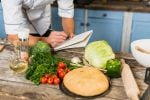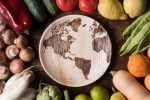Running a restaurant without precise recipe and accurate costing, is like flying a plane without fuel gauges. In 2025, about 60% of new restaurants close within their first year, often due to poor recipe cost management. A restaurant owner in Boston learned this lesson when his seemingly profitable pasta dish was actually losing money. His $24 signature linguine, popular with customers, had hidden costs in imported ingredients and waste that ate up his margins. The real cost? $19 per plate.
But there’s a straightforward solution: recipe costing templates. These tools break down every ingredient to the penny, showing exactly what each dish costs to make. They transform complex calculations into the form of clear, actionable recipe cost calculator data.
For restaurant owners struggling with pricing, this guide provides a systematic approach to recipe costing. We’ll examine practical templates that help:
Calculate exact food costs per serving
Set profitable menu prices
Track ingredient price changes
Monitor portion sizes
Maintain consistent profit margins
This review covers the best recipe costing templates available in 2025, comparing their features, pricing, and real benefits. We’ll look at both basic spreadsheet options and advanced software solutions that fit different restaurant sizes and budgets.
The difference between profit and loss often comes down to pennies per plate. With the right recipe costing template, you’ll know exactly where those pennies are going and, more importantly, how to manage to keep more of them in your bank account.
Boost customer satisfaction with just a few clicks
Most-Loved Features:
- On-demand drivers
- Real-time GPS tracking
- Delivery confirmation photos
- Over 50% of customers report a smoother delivery experience
Step 1: Set Up Your Recipe Costing Template
Organize ingredients and their costs for a clear cost breakdown.
Calculate each ingredient’s cost to control recipe expenses.
Sum up costs for accurate pricing and budgeting.
Gather Necessary Ingredients and Costs
You can start by making a detailed list. Write down every ingredient in your recipe. This includes everything from main components frying oil to the smallest spices. Accuracy is key to understanding food costs.
Purchase costs should be documented. Look at your latest invoices or receipts. Write down the price you paid for each ingredient. What’s important here is jotting down both individual and bulk prices. Bulk prices can often save you money, but they require conversion into recipe-size portions. For example, if you buy flour in a 50-pound bag, you’ll need to work out the cost per pound or cup used in the recipe. This step ensures you capture all costs associated with the recipe.
Calculate Each Ingredient’s Cost Per Recipe
This part is about breaking things down. Take the bulk prices you have and convert them into per-unit costs. Let’s consider sugar. If you bought a 5-pound bag for $1.50, the cost per pound is $0.30. Use this per-unit cost for further calculations.
Next, multiply the cost per unit by the amount you need for the recipe. If your dish requires 2 pounds of sugar, that’s 2 pounds x $0.30 = $0.60. Do this for every ingredient. This helps answer a common question: “What is the formula for calculating food costs?” This approach gives you a precise cost per ingredient.
Sum Up Total Recipe Costs
This is the last step in ingredient costing preparation. Add up the costs of all the ingredients. Confirm all your unit conversions and calculations are accurate. Double-checking now can save you headaches later. When costs fluctuate, accuracy is essential to maintaining profits.
Knowing the total recipe cost is about keeping expenses in line with restaurant goals. Many restaurants aim for a food cost percentage between 28-35% of revenue. This step also informs menu pricing, which we cover later.
Step 2: Menu Pricing Strategies Using Recipe Costing
Set prices by figuring out costs and profit
Compare with competitors to stay competitive
Test and tweak to find what works best
Implement Different Pricing Methods
Cost-Plus Pricing Strategy
You can start with cost-plus pricing, a straightforward method where you add a fixed profit margin to the total cost of a dish. Begin by calculating the food cost percentage. Most restaurants aim for a food cost between 28% and 35% of the menu price.
Calculate Food Costs: Add up all the recipe costs and any related costs, like packaging.
Set Markup: Decide on the profit margin you want. Commonly, restaurants target 10% to 20% per menu item.
Determine Price: Add the food costs and the desired profit margin to get the final price.
Market-Based Pricing Strategy
With market-based pricing, the focus shifts to competitor analysis. This involves researching what other similar restaurants in your area charge for similar dishes.
Research Competitors: Look at three to five competitors. Make a list of menu items’ price vs. quality.
Analyze Differences: Note if they offer any value additions – like side dishes or larger portions.
Align Price: Adjust your pricing based on the analysis to stay competitive. Avoid underpricing your product if the quality stands out, as quality tends to outweigh a deep discount.
Ensure Profit Margin Is Met
Determine Desired Profit Margin Percentage
Deciding your first site and desired profit margin is crucial. Most operators look for profit between 10% and 20%. This figure should cover your operating expenses and contribute to overall business viability.
Evaluate Current Margins: Assess your past profit margins on different menu items to know what works best for your finances.
Set a Goal: Choose a realistic and achievable profit margin. Consider rising food and labor costs, which are major factors in 2025.
Factor in Variable Expenses: You shouldn’t forget to include variable expenses in your calculations, such as utilities and staff wages.
Adjust Recipe Prices
Once the desired margin is set, adjust your recipe prices accordingly in the menu. This may require fiddling with ingredient quantities or sourcing costs.
Regularly Update Costs: Check supplier prices monthly to adapt your menu prices.
Monitor Costs and Sales: See if your prices remain viable and appealing. An ongoing check of costs against sales volumes will help maintain profitability.
Test and Adjust Pricing Strategically
Conduct Test Runs to Check Customer Reception
Before rolling out the menu, testing can provide valuable insights into menu success.
Pilot Test Strategies: Introduce a few items first to a limited audience to gauge reactions.
Collect Feedback: Use surveys or casual chats with customers to gather initial impressions.
Analyze Initial Data. Keep an eye on sales figures to track customer preferences. 40% of operators faced margin compression from value meals, suggesting that prices might need adjustment source.
Adjust Pricing Based on Sales Data and Diner Feedback
Post-test, be prepared to make changes based on the results and customer feedback.
Assess Feedback and Sales Data: Review feedback and sales. Identify bestsellers and items that aren’t appealing.
Tweak Prices: Adjust prices where necessary. Consider if the price is too high for sales to thrive or too low, cutting into margins.
Repeat and Refine: Keep repeating this cycle of testing and adjustment. This not only maintains profitability but also adapts to consumer behavior trends.
Step 3: Use Restaurant Cost Control Software
Simplify costing with the right cost control software.
Enhance accuracy by automating data entry.
Gain insights for better financial decisions.
Choose the Right Software
Selecting restaurant cost control software is key. First, assess the needs of your restaurant. Smaller places need simpler tools; larger venues need robust systems. You should make sure your choice aligns with your budget. Free trials are helpful in testing software before finalizing. Look for features like inventory management and sales integration. These reduce manual processes and improve efficiency. Additionally, consider cloud-based software for remote access.
Compatibility with existing systems matters, so check for integration options. Images of different software dashboards may guide your choice.
Input Recipe Data Into Software
Accurate data entry is vital to effective use of restaurant cost control software. You can start by ensuring all details about recipes are well-documented. This includes the exact amount of each ingredient used. Enter unit costs directly into your system. This is where automation is your friend. Many software options offer bulk file upload features. This means uploading spreadsheets with cost information, saving time.
Software can help with maintaining updated prices of ingredients. Adjust your records regularly to reflect any changes in costs. This ensures current data drives your financial insights. Visual aids like screenshots guiding users through the data entry could be handy.
Analyze Data for Better Financial Insight about Food Costs
Once data is in, the power of the software lies in analysis. You can use built-in reports to see where you can save money. These reports often spotlight trends, such as which dishes cost more to produce over time. Utilize the software’s alerts for cost changes, helping avoid being caught off guard by fluctuating prices.
Regularly download and review your software’s updates to benefit from new features and improve your analysis capabilities. Check for enhancements that could make your system more efficient. Set reminders to keep the software and data current. This guarantees you use the full capabilities provided.
What is the Recipe Cost Calculator Basics?
Understanding recipe costing basics is crucial. Costing involves tracking ingredient prices and calculating the cost per dish. Basic formula: Add up all ingredient costs, factor in waste, and divide by yield. For cost per serving, take total cost and divide by the number of servings. Software streamlines this, making calculations faster and more accurate.
Knowing how to do costing for a recipe ensures your menu is priced for profit. It involves listing every ingredient and its cost, noting amounts and any bulk pricing. You can add labor by calculating time and wages. Adjust figures regularly to maintain precise costs and profits.
Importance of The Recipe Costing Template For Your Business
“A well-costed recipe isn’t just about numbers—it’s about sustaining your restaurant’s future,” says Chef Laura Mitchell, a restaurant consultant specializing in cost control.
Recipe costing templates are essential tools for modern restaurant management. We looked at setting up templates, pricing strategies, and software solutions that help track costs and maximize profits. The key is to regularly update ingredient costs and stay flexible with pricing methods.
Success in restaurant management depends on accurate cost tracking. A recipe costing table template brings order to pricing decisions. It’s a system that grows with your business, helping you make informed choices about menu items and profit margins. In today’s competitive dining space, restaurant owners must explore ways to cut overhead. Finding strategies to reduce food costs without sacrificing quality is essential. This involves not only the accurate costing of ingredients but also negotiating better prices with suppliers and optimizing inventory management.
The next steps are clear: Pick a template that fits your needs, input your data carefully, measure, and commit to regular updates. You can start with one recipe, then expand to your full menu. Remember that precision in costing leads to better business decisions. Understanding the broader economic factors that affect your costs is vital, especially in today’s climate. For example, rising import tariffs can significantly influence ingredient pricing. This is critical for restaurants relying on imported goods. Insights about how these tariffs impact your restaurant’s financial health can be found in this post about the effects of import tariffs on your restaurant’s bottom line.
For restaurant owners who want to maintain profitability in 2025, a good recipe calculator and costing template is not optional – it’s necessary. Your template should be a living document that changes as your business grows. When used correctly, it becomes your financial compass, guiding you toward sustainable profits and smart menu decisions. Understanding the broader economic factors that can impact your restaurant is vital. For instance, fluctuations in import tariffs can dramatically affect ingredient costs, which in turn influences your overall pricing strategy. To learn how these tariffs can impact your restaurant’s bottom line, check out this insightful article on the effects of import tariffs.
Take action today. Choose your template, input your first recipe, and start building a stronger financial foundation for your restaurant.














